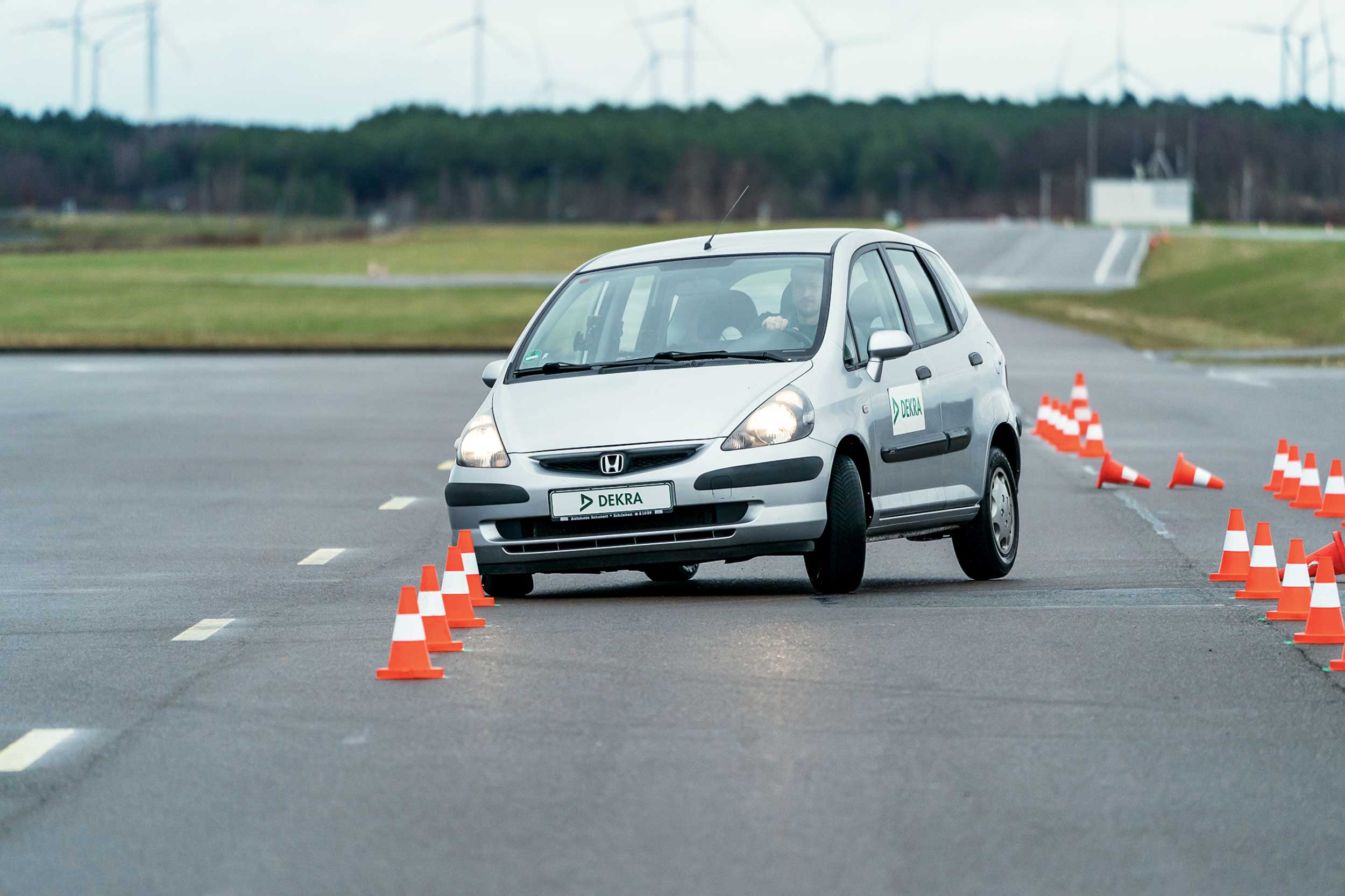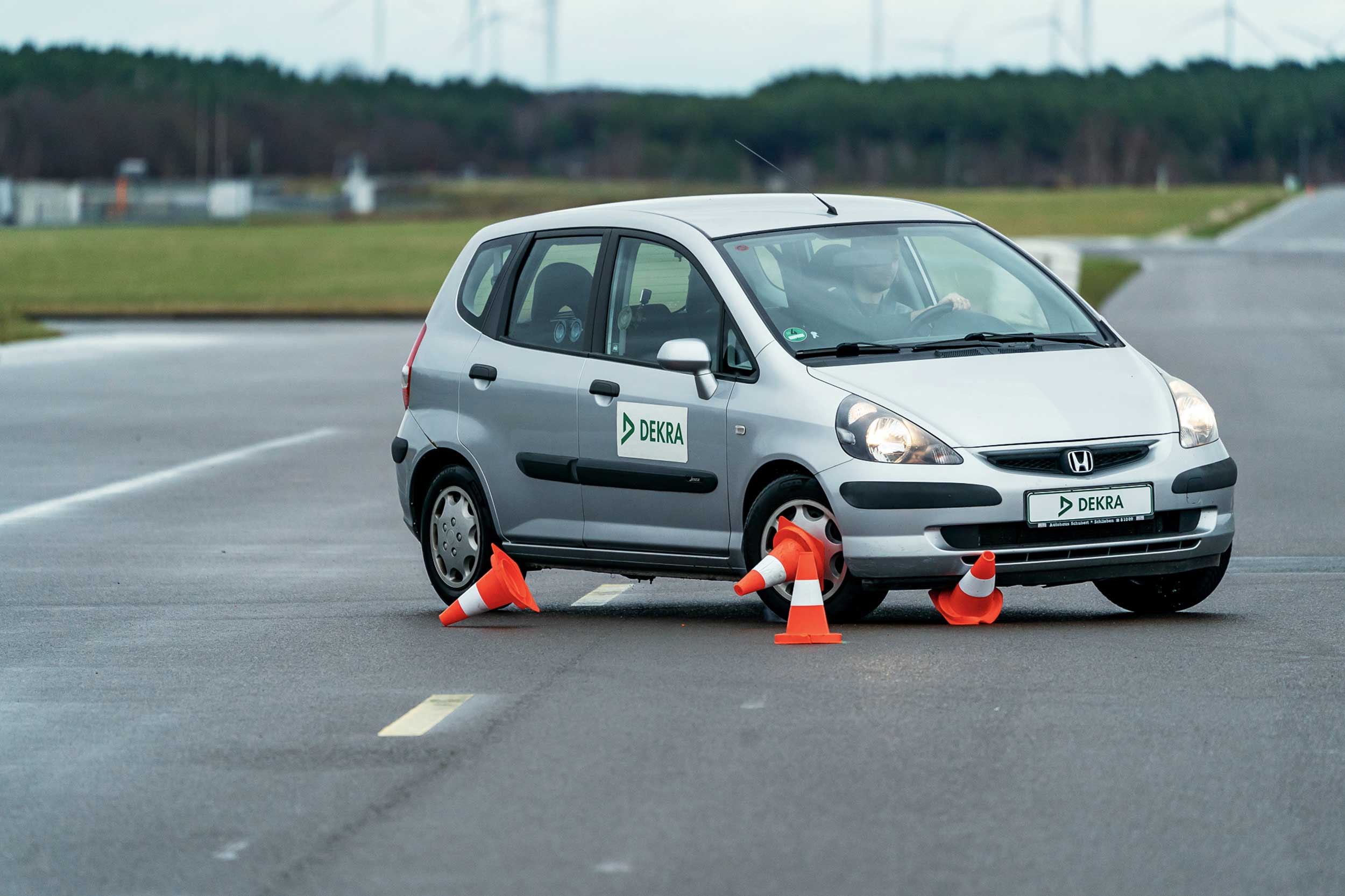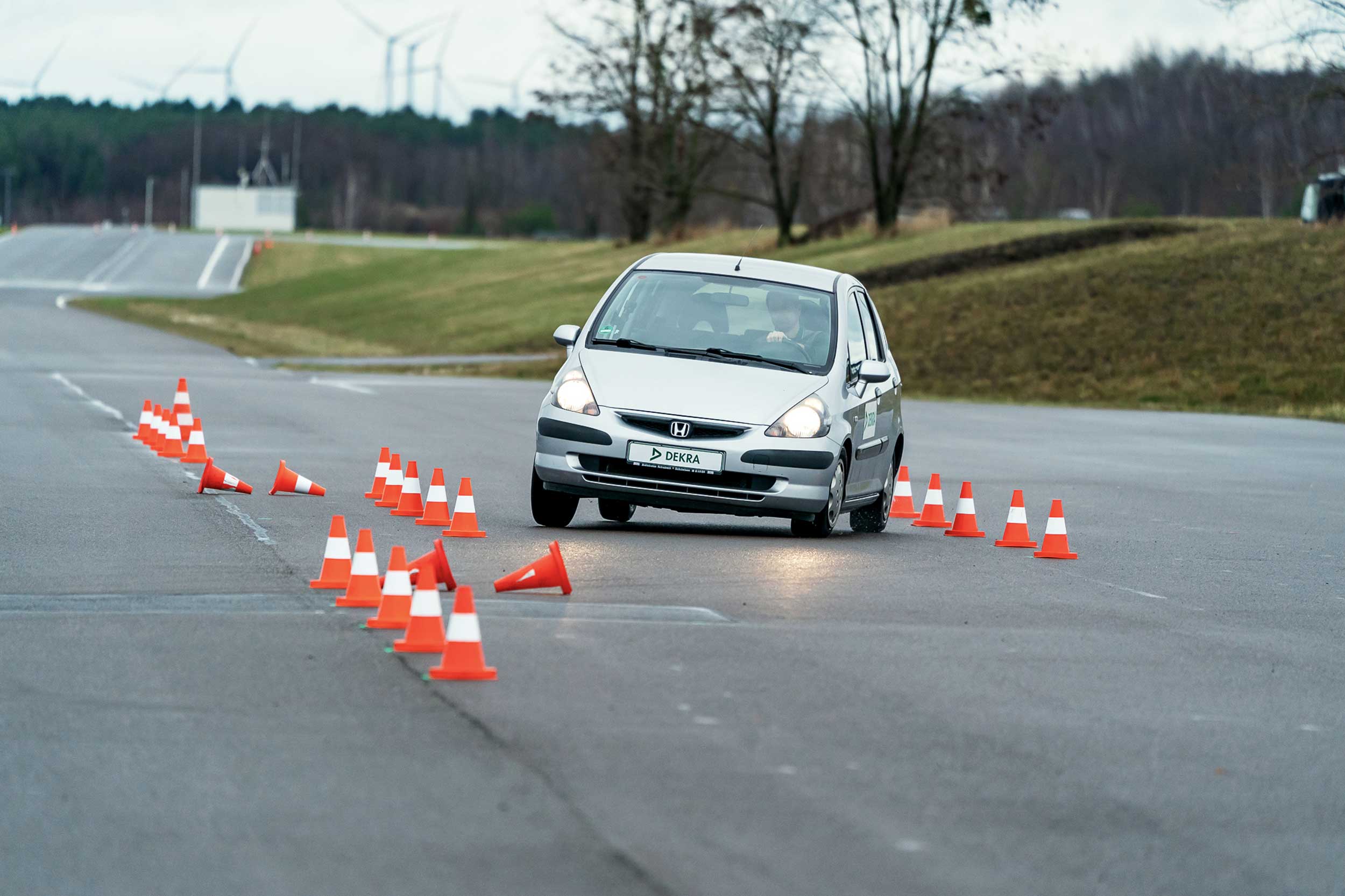DEKRA Test drives with a focus on brakes, tires, and ESP
To shed more light on the influence of vehicle condition and equipment on safety-related driving maneuvers, DEKRA carried out a series of test drives for this report. For test vehicles, the experts at the DEKRA Technology Center at the DEKRA Lausitzring in Brandenburg chose used cars which are very popular with young novice drivers due to their low purchase costs, sporty image, or reputation for being particularly reliable. For the first series of tests, no modifications were made to the vehicles. Only the tire pressure was set according to the manufacturer's specifications. The focus was on the brake units, springs/ dampers, and tires. All vehicles had a valid PTI certificate and were in an overall condition which corresponded to their respective mileage. Deliberately, no vehicles were chosen with tires in poor condition. The tread depth is listed individually in the test descpritions. The temperatures during the tests were between three and five degrees Celsius.
Comparative braking tests were carried out on wet, very non-slip asphalt road surfaces for the VW Golf VII. The original tires used were all-season tires from a premium brand with a minimum tread depth of between 4.8 and 4.0 millimeters. With an output speed of 100 km/h, the braking distance was almost constant at 44.4 meters in several tests on wet roads. Tires, brakes, and shock absorbers were then replaced. The tires were replaced with new winter tires from a premium brand. The braking distance was reduced to an average of 38.7 meters.
Emergency braking from 160 km/h: with new tires, brakes, and shock absorbers, the braking distance is significantly reduced
In the test configuration, the same vehicle was driven at an initial braking speed of 160 km/h. Here the replacements reduced the braking distance from 111.0 to 98.3 meters. The braking distance could thus be reduced by around 11 to 13 percent at both speeds. This corresponds to an enormous gain in safety. This becomes clear in view of the residual speed the vehicle that had not been repaired still had at the point where the one with the replaced parts had already come to a standstill. With an initial speed of 100 km/h this was almost 30 km/h and with an initial speed of 160 km/h it was actually around 55 km/h. On road surfaces with less non-slip coating than that of the test track used, the braking distance is higher and therefore so is the added value of having this maintenance work carried out.
THE CONDITION OF DAMPERS AND SPRINGS HAS A MAJOR IMPACT ON DRIVING SAFETY
The DEKRA experts performed a double lane change with a Honda Jazz. In this process, an evasive reaction to an obstacle suddenly appearing on the roadway and the subsequent steering back to the original lane were simulated. A similar test setup is known colloquially as the "moose test". The driving stability of vehicles is tested while driving through a course marked with traffic cones at higher and higher speeds. No ESP was installed in the test vehicle used. In addition to the condition of the tires – here, in particular, age, tread design, and tread depth – the condition of the dampers and springs is hugely important. They ensure that the contact between tire contact areas and the road surface is maintained, even with rapid load changes.
An area of the test site on which the road surface corresponds to the specifications of the relevant ISO standard served as a test track. The amount of water on the road surface was identical in all test drives. In its original condition, the vehicle was fitted out with all-season tires. The tread depth was at least five millimeters on all tires. Overall, the vehicle handled very pleasantly. The course could be driven through with the unrepaired car at speeds of up to 65 km/h . At higher speeds, the vehicle swerved. After fitting new brakes, tires, and shock absorbers it was possible to drive through at 70 km/h. New all-season tires from a well-known manufacturer were used. It should be taken into account that these tests were carried out by a professional test driver and that the tires in the first series of tests had a good tread depth. Even for experienced "normal" drivers, driving safely through such a course – or going around the obstacle in a real emergency situation – is barely possible at this speed range. In an emergency, inexperienced novice drivers can be expected to lose control even at much lower speeds. The additional safety that is gained through replacing these parts should not be underestimated.
In its original condition, the test vehicle swerves at 70 km/h during the "moose test", and this is with a professional test driver. For novice drivers, the vehicle would be uncontrollable in such a situation, even at significantly lower speeds


-
 Moose test
Moose test -

-

ESP CAN PREVENT SKIDDING ACCIDENTS AND DRIFTING OUT OF LANE
The third test carried out shows the huge importance that condition of the vehicle, particularly in terms of the chassis, brakes, and the correct and good-quality tires, has for the effectiveness of built-in ESP systems. The BMW 1 Series (E87) that was used was equipped with name-brand summer tires. The tread depth was 2.2 and 2.6 millimeters on the front axle and 1.7 and 2.0 millimeters on the rear axle. The car was accelerated up to 130 km/h three times on a wet asphalt surface. A fast so-called sinusoidal steering maneuver with an extended holding time and a steering angle amplitude of 125 degrees was initiated at a predetermined point by a steering robot. In terms of actual driving, this roughly corresponds to a sudden evasive maneuver. Normally it is not a problem to keep the vehicle stable in this situation using ESP. However, even though the ESP was working properly, the vehicle swerved during several test drives. This shows that the ESP control is only effective to the extent to which the chassis, brakes, and tires can transfer the corresponding forces to the road.
THE LIMITS SET BY DRIVING DYNAMICS
For the second series of tests, the brakes and shock absorbers were replaced and the wheels were fitted with new tires of the same type. In each of the three test drives after this repair, there was no loss of traction at any point. The vehicle was consistently caught by the ESP and remained stable. A further series of tests was carried out to illustrate the effectiveness of the ESP. An Audi A3 Sportback was fitted with a steering robot in order to generate a reproducible maneuver, as in the previous tests – this time corresponding to a quick evasive action. The ground was a wet asphalt surface and the driving speed was 80 km/h. With the ESP switched on, the vehicle did tilt slightly, but it was immediately stabilized by the ESP's control intervention and would therefore have remained fully under control. In the same test configuration, but with the ESP switched off, the vehicle spun on its vertical axis in an uncontrolled manner. Countering this would have been impossible, even for the experienced test driver.
The tests strikingly show how important it is for vehicles to be in a technically sound condition. Especially when buying a used car, you should therefore hold back part of the budget you have available for any necessary inspection and maintenancemeasures. Reliable and stable contact between the tires and the road is essential in all road conditions, because only then can it be guaranteed that assistance systems, such as the ABS and ESP, will be effective. In the case of young novice drivers in particular, the idea that older or worn tires are fine to get started with or for low mileage requirements must be rejected. The major potential benefits of ESP for the prevention of skidding accidents or lane departure accidents has been clearly proven in studies. Cars without ESP should therefore not be bought, especially by beginner drivers.